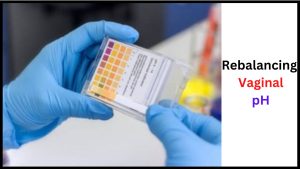
Are you dealing with recurring vaginal discomfort and infections? Are you aware of Rebalancing Vaginal pH?
If so, maintaining a balanced vaginal pH could be the key to alleviating your troubles.
The pH level in the vagina plays a crucial role in maintaining a healthy environment, preventing the overgrowth of harmful bacteria, and maintaining the natural flora.
In this article, we will explore some effective ways to rebalance your vaginal pH, helping you regain control over your vaginal health and overall well-being.
So, let’s dive in and discover the simple yet powerful methods to restore harmony to your most intimate area.
Table of Contents
Rebalancing Vaginal pH: Simple methods to restore harmony.
Understanding Vaginal pH
What is vaginal pH?
Vaginal pH refers to the level of acidity or alkalinity in the vagina.
It is measured on a scale of 0 to 14, with a pH of 7 considered neutral.
In a healthy woman, the vaginal pH is slightly acidic, typically ranging from 3.8 to 4.5.
This acidic environment is maintained by a delicate balance of naturally occurring bacteria, primarily lactobacilli.
The importance of maintaining vaginal pH
Maintaining a balanced vaginal pH is crucial for overall vaginal health.
The acidic pH helps to prevent the overgrowth of harmful bacteria and yeast that can lead to infections such as bacterial vaginosis and candidiasis (yeast infection).
Additionally, a balanced vaginal pH helps to keep the vaginal tissues healthy and moisturized, reducing the risk of dryness, itching, and discomfort.
Common causes of vaginal pH imbalance
Several factors can disrupt the natural balance of vaginal pH.
These include poor hygiene practices, the use of harsh soaps or douches, hormonal changes, certain medications (such as antibiotics), and sexual intercourse.
Additionally, wearing tight-fitting, non-breathable clothing or using irritating contraception methods can also contribute to an imbalance in vaginal pH.
Identifying these causes and taking steps to address them can help restore and maintain a healthy pH level.

Symptoms of Vaginal pH Imbalance
Recognizing signs of an imbalanced pH
An imbalanced vaginal pH can manifest through various signs and symptoms.
These may include unusual vaginal discharge, changes in odor, itching, irritation, and discomfort during sexual intercourse or urination.
It is important to pay attention to these signs as they can indicate an underlying pH imbalance that may require attention and treatment.
Associated symptoms and discomfort
In addition to the physical symptoms mentioned above, an imbalanced vaginal pH can also lead to emotional and psychological discomfort.
Women may experience embarrassment, self-consciousness, and a decrease in sexual confidence due to the unpleasant odor or abnormal discharge associated with pH imbalance.
It is important to address these symptoms to restore not only physical well-being but also mental and emotional well-being.

Diagnosing Vaginal pH Imbalance
Visiting a healthcare professional
If you suspect a vaginal pH imbalance, it is important to consult a healthcare professional, such as a gynecologist or primary care physician.
They will be able to perform a thorough examination, evaluate your symptoms, and recommend appropriate treatment options.
It is crucial not to attempt self-diagnosis, as other vaginal infections may mimic the symptoms of a pH imbalance.
Medical examinations and tests
During the consultation, the healthcare provider may conduct a physical examination to assess the condition of the vagina and cervix.
They may also collect a sample of vaginal discharge for laboratory analysis, which can help determine the exact cause of the pH imbalance.
These examinations and tests will provide valuable information for an accurate diagnosis and guide the treatment plan.

Home Remedies for Balancing Vaginal pH
Maintaining proper hygiene
Practicing good hygiene is essential for maintaining a healthy vaginal pH.
It is important to wash the external genital area with mild, unscented soaps and warm water.
Avoid using harsh soaps, douches, or scented products, as they can disrupt the natural balance of the vaginal pH and irritate the delicate tissues.
Avoiding douching and harsh products
Douching, the practice of flushing water or other fluids into the vagina, should be avoided as it can disturb the natural pH balance.
The vagina is self-cleaning and does not require douching.
Furthermore, using harsh soaps, perfumes, or sprays in the genital area can disrupt the optimal pH environment.
Opt for gentle, fragrance-free products specifically formulated for intimate hygiene.
Optimla clothing choices
Clothing choices also play a role in maintaining vaginal pH balance.
It is advisable to wear breathable, cotton underwear that allows air circulation and absorbs excess moisture.
Avoid tight-fitting clothes or synthetic fabrics that can trap heat and moisture, creating an environment favorable for bacterial overgrowth.
Balanced diet and hydration
A well-balanced diet and proper hydration can contribute to maintaining a healthy vaginal pH.
A diet rich in fruits, vegetables, whole grains, and lean proteins can provide essential nutrients and support a healthy immune system.
Additionally, drinking an adequate amount of water helps to flush out toxins and maintain optimal hydration levels.
Use of natural remedies
Certain natural remedies, such as probiotics and tea tree oil, may help restore and maintain a healthy vaginal pH.
Probiotic supplements or yogurt containing live cultures can help replenish lactobacilli bacteria naturally found in the vagina.
Tea tree oil, when diluted properly, can provide soothing properties and help maintain the balance of vaginal pH.
However, it is important to consult with a healthcare professional before using any natural remedies to ensure safety and effectiveness.

Medical Treatments for Vaginal pH Imbalance
Prescription medications
In some cases, prescription medications may be necessary to treat a vaginal pH imbalance.
These medications may include oral antibiotics to eliminate harmful bacteria or antifungal medications to treat yeast infections.
It is essential to follow the prescribed dosage and duration of treatment to effectively rebalance the pH and prevent recurrence.
Topical treatments and creams
Topical treatments, such as creams or gels, may be recommended by healthcare professionals to restore vaginal pH balance.
These treatments are typically applied directly to the vagina and can include antifungal creams, hormonal creams, or estrogen-based treatments.
They work by targeting the underlying cause of the imbalance and promoting a healthy pH environment.
Probiotics and supplements
Probiotics, available in oral form or as vaginal suppositories, provide a natural and effective way to restore and maintain a healthy vaginal pH balance.
These supplements contain beneficial bacteria, such as lactobacilli, which can help replenish the vaginal flora and promote a balanced pH.
Consultation with a healthcare professional is recommended to determine the most suitable probiotic strain and dosage.
Prevention of Vaginal pH Imbalance
Practicing safe sex
Engaging in safe sex practices can help prevent the introduction of harmful bacteria and reduce the risk of developing an imbalanced vaginal pH.
It is important to use barrier methods, such as condoms, to protect against sexually transmitted infections (STIs) and maintain a healthy vaginal environment.
Additionally, ensuring proper lubrication during sexual activity can reduce friction and irritation.
Using non-irritating contraception methods
Choosing non-irritating contraception methods can help maintain vaginal pH balance.
Some contraceptives, such as diaphragms or spermicides, can disrupt the natural pH environment. Opting for alternative methods, such as hormonal contraception or barrier methods, can minimize the risk of pH imbalance.
Avoiding excessive antibiotic use
Excessive or unnecessary use of antibiotics can disrupt the delicate balance of vaginal pH.
Antibiotics not only target harmful bacteria but also affect the beneficial lactobacilli, leading to an imbalance.
If prescribed antibiotics are necessary, it is advisable to discuss with the healthcare professional the use of probiotics or other measures to minimize disruption to vaginal pH.
Regular health check-ups
Regular health check-ups, including gynecological examinations, are vital in preventive care and early detection of any potential vaginal pH imbalances.
These check-ups allow healthcare professionals to monitor the vaginal environment, identify any changes or abnormalities, and provide appropriate guidance and treatment if needed.

The Impact of Menstrual Cycle on Vaginal pH
How the menstrual cycle affects pH balance
The menstrual cycle can influence vaginal pH due to hormonal fluctuations.
During menstruation, the pH level may rise, becoming less acidic, which can create an environment for the overgrowth of bacteria or yeast.
Understanding these changes and taking preventive measures can help maintain a healthy pH balance throughout the menstrual cycle.
Tips for maintaining pH during menstruation
During menstruation, it is crucial to change sanitary products frequently to avoid prolonged exposure to excess moisture.
Opt for unscented and hypoallergenic products to reduce irritation.
Additionally, maintaining proper hygiene by washing the genital area with mild soap and warm water, avoiding douching, and wearing breathable cotton underwear can help prevent pH imbalance during this time.

The Role of Hormonal Changes in Vaginal pH
Hormonal fluctuations and pH levels
Hormonal changes throughout a woman’s life, such as puberty, pregnancy, and menopause, can impact vaginal pH levels.
Estrogen plays a crucial role in maintaining a healthy vaginal environment.
Reduced estrogen levels can result in a higher pH, leading to increased susceptibility to infections and discomfort.
Understanding these fluctuations and seeking appropriate treatments can help manage pH imbalances effectively.
Navigating pH changes during menopause
During menopause, when estrogen levels decline, vaginal pH can become less acidic, increasing the risk of vaginal infections and discomfort.
Hormone replacement therapy (HRT), under the guidance of a healthcare professional, may be recommended to restore estrogen levels and maintain optimal pH balance.
It is essential to consult with a healthcare professional to determine the most suitable treatment approach.
Managing pH during pregnancy
Pregnancy hormones can cause changes in vaginal pH, which may lead to increased vulnerability to infections.
Regular prenatal care enables healthcare professionals to monitor vaginal health and provide appropriate treatments if necessary.
Maintaining good hygiene, staying hydrated, and following a balanced diet can also help support optimal pH balance during pregnancy.

Diet and Vaginal pH
The influence of diet on vaginal pH
Diet plays a significant role in maintaining a balanced vaginal pH.
Consuming a diet rich in fruits, vegetables, whole grains, and lean proteins can support optimal vaginal health.
These nutrient-dense foods provide essential vitamins, minerals, and antioxidants that help strengthen the immune system and promote a healthy vaginal environment.
Alkaline vs. acidic foods
Some foods can influence the overall acidity or alkalinity of the body, potentially impacting vaginal pH.
While the vagina has its own self-regulating mechanism, consuming an excess of highly acidic or highly alkaline foods may influence the pH to some extent.
However, it is important to note that the impact of individual foods on vaginal pH is minimal compared to overall lifestyle and hygiene practices.
Balancing pH through nutrition
Maintaining a balanced diet and proper hydration can indirectly support a healthy vaginal pH.
It is recommended to consume a variety of foods that provide a wide range of nutrients.
Probiotic-rich foods, such as yogurt and fermented vegetables, can also contribute to a healthy vaginal flora.
Furthermore, staying well-hydrated helps to flush out toxins and maintain optimal moisture levels in the vagina.
Rebalancing Vaginal pH: Simple methods to restore harmony.
Conclusion
Understanding and maintaining a healthy vaginal pH is essential for overall vaginal health and well-being.
By recognizing the signs, causes, and impact of pH imbalances, women can take proactive steps to maintain a healthy balance.
From practicing good hygiene to considering medical treatments when necessary, there are various options available to restore and maintain optimal vaginal pH.
By prioritizing vaginal health, women can enjoy a comfortable, confident, and infection-free lifestyle.


